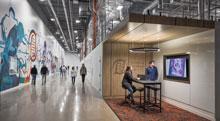
The Future of Work Is Here … And It’s Built on Human Connections

The BHDP team joined leaders from the corporate real estate community in Washington, DC, at the 2024 CoreNet Global Summit | North America to explore people-centric real estate strategies across all domains of the profession.
As the business community emerges from a period of unprecedented uncertainty, one thing remains true: people power our organizations. This year’s Summit was flush with content supporting the overarching premise that effective real estate strategies start and end with one thing in mind: human connections. Here’s what we learned:
Social Bonds Connect Flexible, Resilient Organizations
The power of social bonds within organizations cannot be overstated. Research shows that familiarity, trust, and accountability are the product of frequent, meaningful interactions among people. Physical presence is more effective than remote interactions when it comes to building trust. While people will continue to perform the functions of their jobs in environments that best support their immediate needs— including the home—the fact remains. Being together is an investment with long, stable returns.
Exceptional Workplaces Promote Team Performance
After several years of stable results, self-reported productivity has declined over the last year. The culprit? Strained connections, declining well-being, lower energy, and a less-inspired workforce. High-performing teams consistently emphasize the importance of strong interpersonal connections, noting that the workplace is crucial in building team identity, cohesion, morale, and overall performance. The more time people spend apart, the weaker their connections become. A sound workplace strategy promotes the team’s performance. For more on how design, science, and happiness intersect to influence well-being and productivity, check out this Trends +Tensions podcast, "Where Science, Happiness, and Design Intersect."
Addressing the Pandemic’s Lingering Impact on Well-Being
With loneliness and depression on the rise and self-reported well-being in decline, real estate leaders must confront the reality that the workforce they serve is facing a crisis. Experts agree the workplace can be a powerful tool for fostering human connections, but only if supplemented by solid management practices. The future of workplace strategy continues to point towards an integrated approach that extends across services to provide an intentional, nuanced employee experience. As mentioned in Justin Ferguson’s blog, “Don’t Overlook Existing Work Elements to Improve Well-Being,” organizations seeking to support the well-being of their people should develop a comprehensive approach that considers the holistic physical, mental, and emotional needs of their employees.
The Role of AI in Transforming Work
While the impact of artificial intelligence is not yet clear, experts agree that AI is here for our tasks. In the coming years, routine work will primarily be automated, and artificial intelligence will increasingly become a tool to augment the high-value work that makes us human. Tasks requiring creativity, ingenuity, and empathy will continue to be driven by a highly skilled human workforce empowered by new tools and workflows.
We Agree on the “What,” The Real Challenge is “How?”
With the widespread adoption of digital workflows, the introduction of artificial intelligence, the looming exit of the Baby Boomer generation from the workforce, and the sustained interest in driving meaningful human connections among a highly-skilled, physically distributed workforce, the future of work is here. Leaders in the industry recognize there are no easy answers to complex problems. The seasoned solution remains: a time-tested, human-centered, multi-faceted design process is the surest path forward.
If you're interested in learning more about our design process, complete our contact form today.
Author
Content Type
Date
November 13, 2024
Market
Practice
Topic
Innovation
Hybrid Work



